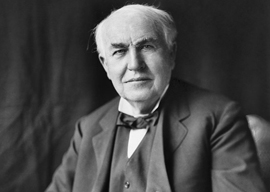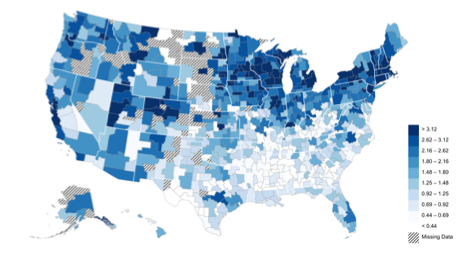
December 06, 2017

Thomas Alva Edison
Source: Library of Congress
Interestingly, Chetty claims that moving blacks to college towns would benefit them greatly:
We estimate that moving a child from a CZ that is at the 25th percentile of the distribution in terms of innovation (e.g., New Orleans, LA) to the 75th percentile (e.g., Austin, TX) would increase his or her probability of becoming an inventor by at least 17% and potentially as much as 50%.
Unfortunately, that is not supported in a recent Stanford database of school-district test-score results that I wrote about in my 2016 Taki’s column “Crevasses in the Classroom.” Madison has one of the worst white-black racial disparities in school performance in the country, as does Evanston (Northwestern U.), Chapel Hill (U. of North Carolina), Durham (Duke), Charlottesville (U. of Virginia), and Ann Arbor (U. of Michigan). The single biggest racial divide in the country is in the most notoriously leftist town: Berkeley (UC Berkeley).
Evidently, innovative liberal cities indulge African-Americans’ worst tendencies. In contrast, the best black school performance tends to be found in more conservative exurbs, such as Frisco, Tex., the corporate home of the Dallas Cowboys.
Chetty’s map of where inventors grow up supports a number of theories about America.

Chetty’s map confirms Daniel Patrick Moynihan’s Law of the Canadian Border that positive social-science metrics correlate with how far north a state is.
And the map offers validation for historian David Hackett Fischer’s famous thesis in Albion’s Seed that the U.S. was settled by four waves out of the British Isles that spread from east to west along different latitudes.
The most inventive were the northernmost, the New England Puritans, who picked up Germans and Scandinavians on similar cultural wavelengths as they moved through the northern Midwest and out to the Pacific Coast as far south as the San Francisco Bay.
The second-most economically productive group, the Midlanders, started out among Pennsylvania Quakers and spread through Iowa to Southern California.
The Scots-Irish who stuck to the healthier mountains in places like North Carolina and the Ozarks and the Lowland Southerners were not as technologically innovative.
But that doesn’t mean they are totally lacking in potential. For example, Lyndon Baines Johnson and other Southern senators contrived to site the main NASA facilities—such as Houston, Tex., Huntsville, Ala., and Cape Canaveral, Fla.—in the South to push that lagging region into the space age.
Notwithstanding the crucial contributions of the famous German rocket scientists and the less well-known Canadian engineers, many NASA engineers were Southern boys who rose admirably to the occasion.
Similarly, Sam Walton built the biggest fortune in the world by betting that Ozark hillbillies could staff the most aggressive corporation in America, Walmart.
Steve Case, founder of AOL, and J.D. Vance, author of Hillbilly Elegy, this week announced a small investment fund, Rise of the Rest, to promote start-ups in the flyover parts of America. While there are hardheaded reasons why venture capital mostly flows to only a few parts of the country, this kind of undertaking at least has promise.
Not surprisingly, studies by Caroline Hoxby of Stanford and Christopher Avery of Harvard show that the most overlooked high-potential youth in the country tend to be white males from flyover states.
Kind of like Thomas Alva Edison.